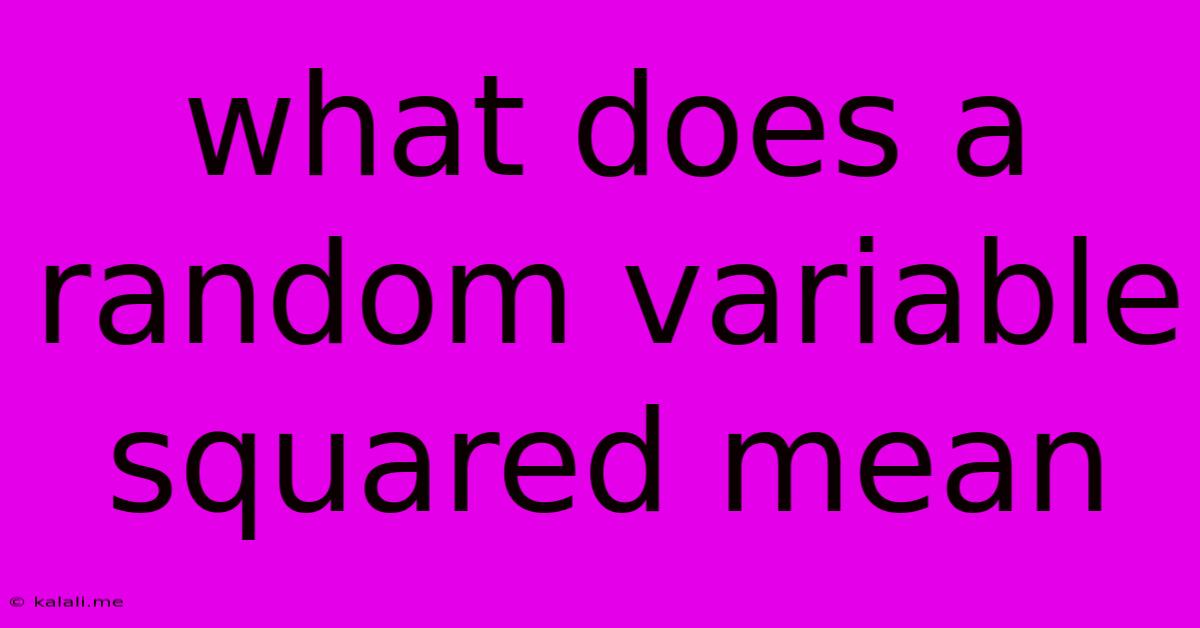What Does A Random Variable Squared Mean
Kalali
Jun 10, 2025 · 3 min read

Table of Contents
What Does a Random Variable Squared Mean? A Deep Dive into Statistical Concepts
This article explores the meaning and implications of squaring a random variable, a fundamental concept in statistics and probability. Understanding this allows you to grasp more advanced statistical techniques and their applications in various fields. We will cover the intuitive meaning, mathematical implications, and practical examples.
What is a Random Variable?
Before diving into squaring, let's refresh our understanding of random variables. A random variable is a variable whose value is a numerical outcome of a random phenomenon. Think of flipping a coin: the outcome (heads or tails) can be represented numerically (e.g., 1 for heads, 0 for tails). This numerical representation is the random variable. Other examples include the height of students in a class, the temperature of a city, or the number of cars passing a certain point on a highway.
So, What Happens When You Square It?
Squaring a random variable (X²), essentially, transforms the original data. It doesn't just change the numbers; it significantly alters their distribution and meaning, primarily focusing on the magnitude of the variable, completely disregarding the sign.
-
Magnitude Focus: The most crucial aspect is that squaring removes the negative values. If your original random variable includes negative numbers (e.g., temperature differences), squaring them results in positive values, emphasizing the magnitude of deviation from zero rather than the direction.
-
Distribution Change: Squaring often leads to a skewed distribution, even if the original variable followed a normal (symmetrical) distribution. The squared variable tends to have a heavier tail on the right side (positive values). This altered distribution can significantly affect calculations of things like the average and standard deviation.
-
Variance and Standard Deviation: Squaring plays a pivotal role in calculating the variance and standard deviation. The variance, a measure of dispersion, is calculated using the squared differences from the mean. The standard deviation is simply the square root of the variance, giving us a measure in the original units. Therefore, understanding squared random variables is essential for understanding these key statistical measures.
Practical Implications and Examples
Let's illustrate with examples:
-
Error Analysis: In experiments, squared errors (the difference between observed and expected values squared) are frequently used to minimize the impact of both positive and negative errors. The sum of squared errors forms the basis of many statistical methods such as linear regression.
-
Financial Modeling: In finance, squaring returns on investments (profit or loss) emphasizes the magnitude of gains or losses, irrespective of their direction. This is relevant when assessing risk and volatility.
-
Physics: Many physical quantities, like kinetic energy (½mv²), inherently involve squaring a random variable (velocity in this case) to quantify a specific characteristic of the system.
-
Signal Processing: In signal processing and image analysis, squaring is often used to enhance the signal-to-noise ratio, emphasizing stronger signals and suppressing noise.
Mathematical Considerations:
It's crucial to understand that squaring a random variable changes its expected value (mean), variance, and higher moments. The expected value of X² (E[X²]) is not simply the square of the expected value of X (E[X])². The difference between these two values, E[X²] - (E[X])², is the variance of X. This relationship underpins many statistical calculations.
Conclusion:
Squaring a random variable is not a trivial operation. It significantly alters the data's distribution and meaning, primarily emphasizing magnitude over direction. Understanding this transformation is critical for interpreting statistical results in various applications, from basic statistical analysis to advanced modeling in fields like finance, physics, and engineering. Therefore, a firm grasp of this concept is essential for anyone working with statistical data and probabilistic models.
Latest Posts
Latest Posts
-
How Many Drops In A Teaspoon
Jun 11, 2025
-
How Many Drops To A Teaspoon
Jun 11, 2025
-
How Many Mondays In A Year
Jun 11, 2025
-
First Past The Post Vs Proportional Rep
Jun 11, 2025
-
First Past The Post Versus Proportional Representation
Jun 11, 2025
Related Post
Thank you for visiting our website which covers about What Does A Random Variable Squared Mean . We hope the information provided has been useful to you. Feel free to contact us if you have any questions or need further assistance. See you next time and don't miss to bookmark.